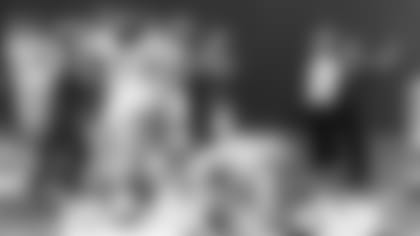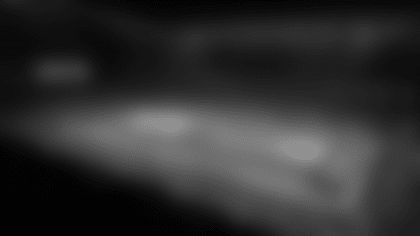The game was over.
The New York Giants just had to run out the clock and the Eagles' 1978 season would have effectively ended. On television, fans at the Meadowlands were seen walking up the stairs and out the exits as the credits projected over them.
Then, the unthinkable happened.
The Giants didn't take a knee, an unpopular practice at the time, and a botched handoff resulted in a fumble off the cold turf. Herman Edwards scooped up the ball and ran into the end zone with 20 seconds remaining to put the Eagles ahead 19-17.
The "Miracle of the Meadowlands" was born.
It's a story that all Eagles fans know well. It's a birthright – a tale parents tell their young fans before they're old enough to pronounce "Pisarcik," the Giants' second-year quarterback Joe Pisarcik who failed to deliver the ball to Larry Csonka.
And thanks to Eagles team photographer Ed Mahan, those fans can forever see the historic play.
It would have been easy for any photographer to pack up and call it a night when the Giants took over. After all, at that time, photos had to be developed in a dark room with chemicals through a much longer process than today's digital world.
And for that reason, just about every photographer did. That is, except one.
Mahan stayed put, knowing he could still get some good shots for the team publications. When Edwards ran in disbelief toward the nearly empty end zone, Mahan captured the only photographs of the iconic moment in Eagles lure.
"I still can't believe it," Mahan says. "All the Giants had to do was a play and formation that didn't exist. And boy, after that play, it did. I just happened to be there for the moment."
Mahan, admittedly, did not see that ending coming either. His focus at that moment was on rookie linebacker Reggie Wilkes for the following season's team yearbook. Isolated game shots were hard to come by and this was the perfect opportunity for an easy one.
He was shooting on a borrowed zoom lens from a friend. That newer technology allowed for a much better view than normal. When the play developed, Mahan had to adjust the focus on the unfamiliar lens quickly and follow it intently.
He did it perfectly.
"I'm dialed in on Reggie and just clicking away, looking for him to get into some movement," Mahan says. "And gee, doesn't the ball just go across the lens. I just followed the bouncing ball and next thing I knew, there's Herm Edwards running right at me.
"It's all instincts," Mahan adds. "And if you think about it, you're not doing it right."
Mahan had the perfect lens, timing, and skills to take the photo. He captured not only the whole play but the celebration in the end zone as well. The whole team, along with public relations assistant Chick McElrone and general manager Jim Murray, jumped in celebration.
"That was a moment of what life can do for you and sports can do," Murray says. "Edwin is not just a photographer but an artist. He doesn't just capture the images that you see. He captures the feeling."

The play was "life-changing" for Murray, and it spurred a run that ended the Eagles' 18-year playoff drought. Murray immediately called owner Leonard Tose, who was in Texas dealing with health issues. The whole team lined up at a payphone with Murray to relish in the victory.
"I was thinking I have to fly back to Texas and tell Leonard why we lost," Murray says. "Leonard got better and we got better."
That photo also birthed the "Ed Mahan Rule." No photographer was to leave early again and risk missing a moment like the one that fell into Mahan's lap. Mahan, like the game, became legendary.
But Mahan wasn't totally alone in that end zone. Phil Tuckett, an NFL Films cinematographer, got the only video shot from that angle. With the two of them behind the end zone was legendary Philadelphia sports writer Ray Didinger.
Didinger wanted to escape the postgame elevator rush at the Meadowlands. So after a Ron Jaworksi interception seemingly sealed the game's fate, he went to the field to beat the crowds.
"Phil's there shooting it, Ed's there shooting it, and I'm there next to them taking notes furiously," Didinger says. "We all had the same sense of disbelief. It was history and we were there to see it.
"I think it speaks volumes about what a professional Ed is," he adds. "As long as something was happening on the field, he was going to be there shooting it. And because he knew better, he ended up getting the photographs that immortalized a moment."
The drama didn't end there. When Mahan got back to his office in Philadelphia close to midnight, he received a desperate message from a friend in need. It was George Reynolds, the newly named editor of the Philadelphia Journal. The sports and entertainment tabloid was a new publication that lasted for four years.
Reynolds sent one of Mahan's former interns, now working at the Journal, to ask if Mahan could share his photo.
"He's like 'They're all going to get fired!'" Mahan says. "'Did you get the shot? Can you help?'"
Mahan could have been prideful and kept his work for himself. Instead, he told Reynolds to run the photograph on the front page of his paper with no credit.
"I said, 'Look, I'll make up a whole set of the sequence and you can have it,'" Mahan says. "George Reynolds said for years that I saved his job."
Mahan could recount hours of unbelievable stories and memorable moments in his 50-year career as the Eagles' team photographer. He's been there for just about every one of the franchise's most significant moments.
But nothing comes close to the magnitude of that play, one that gave us the victory formation, and the photograph generations of Eagles fans have seen and will continue to see.
"There's being in the right place at the right time," Didinger says. "And then there's being a skilled-enough photographer to take advantage of that and take a picture that lasts a lifetime. And Ed has done that."















